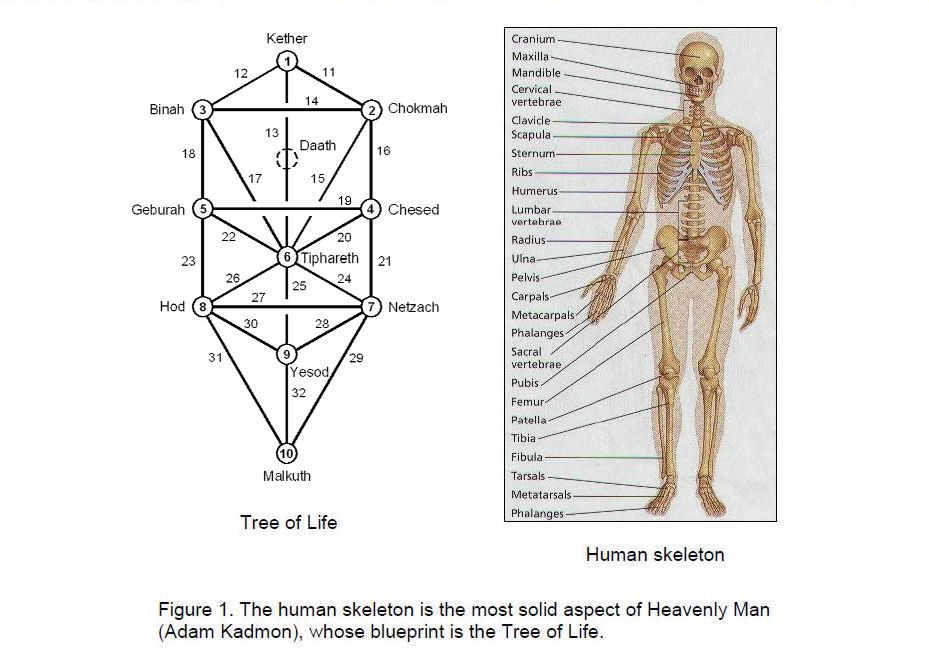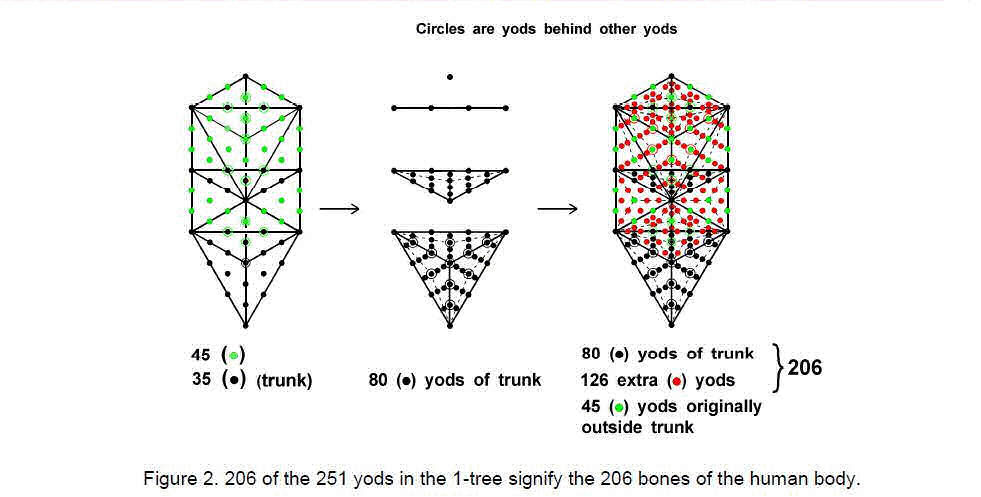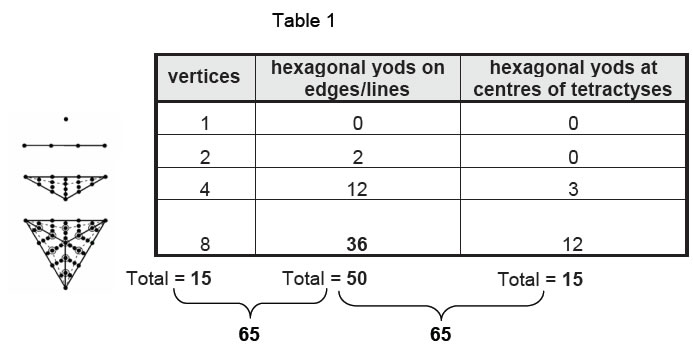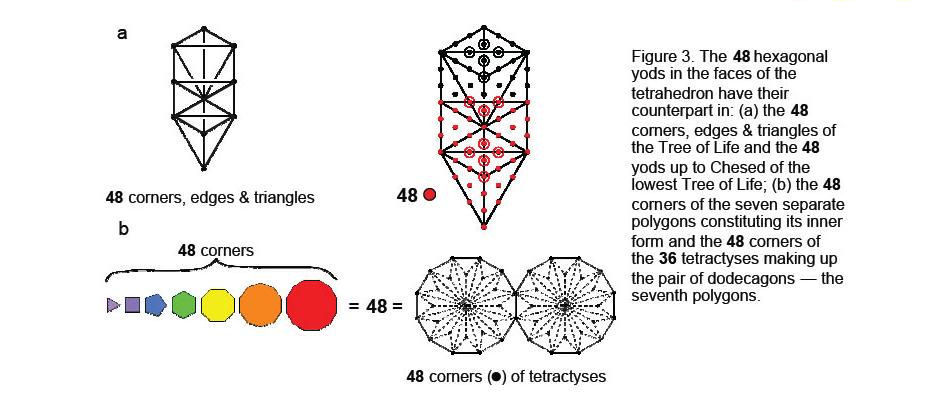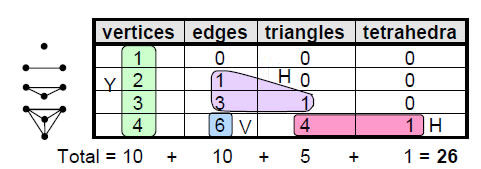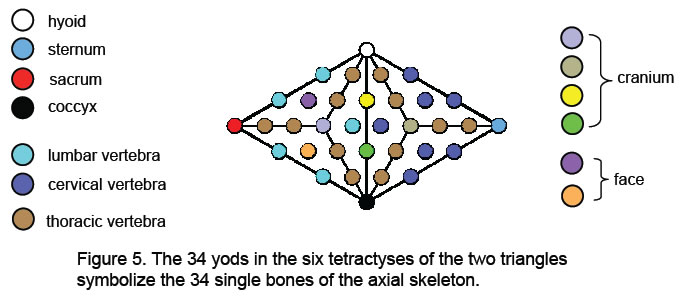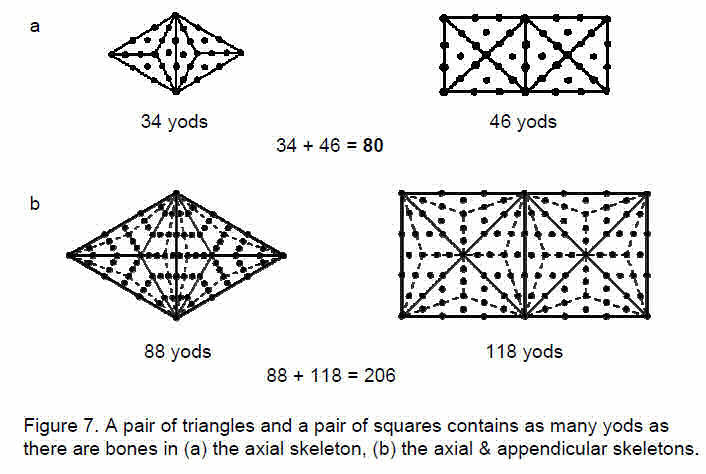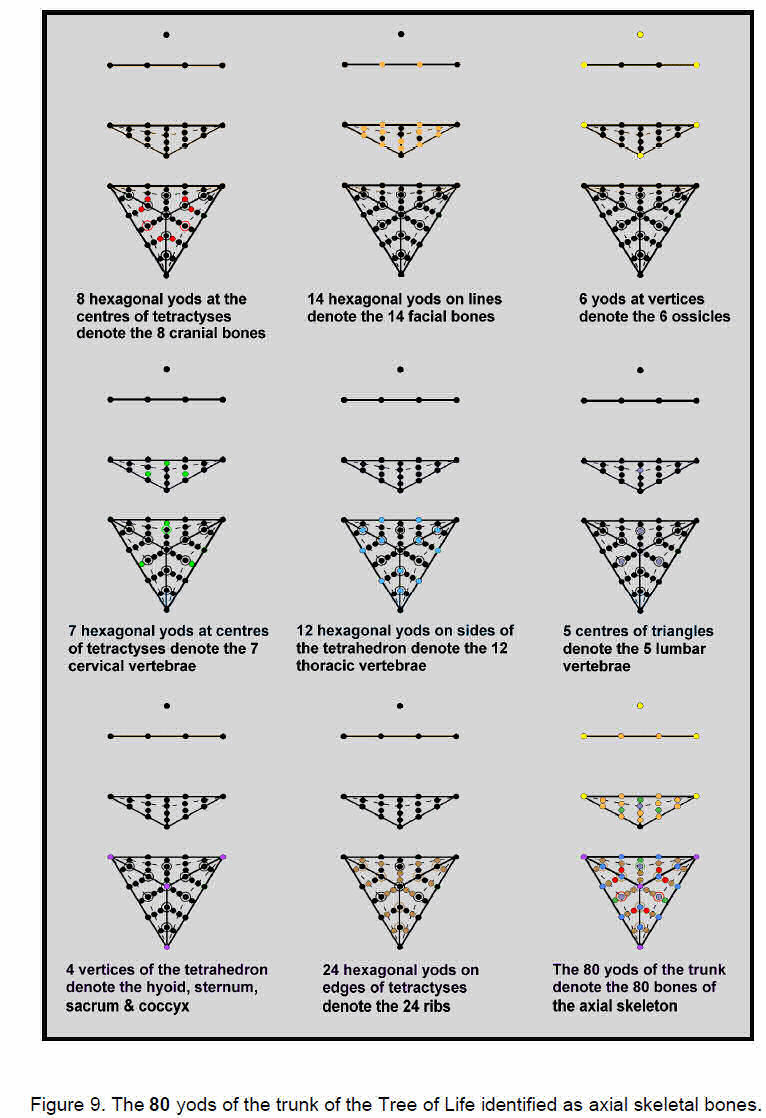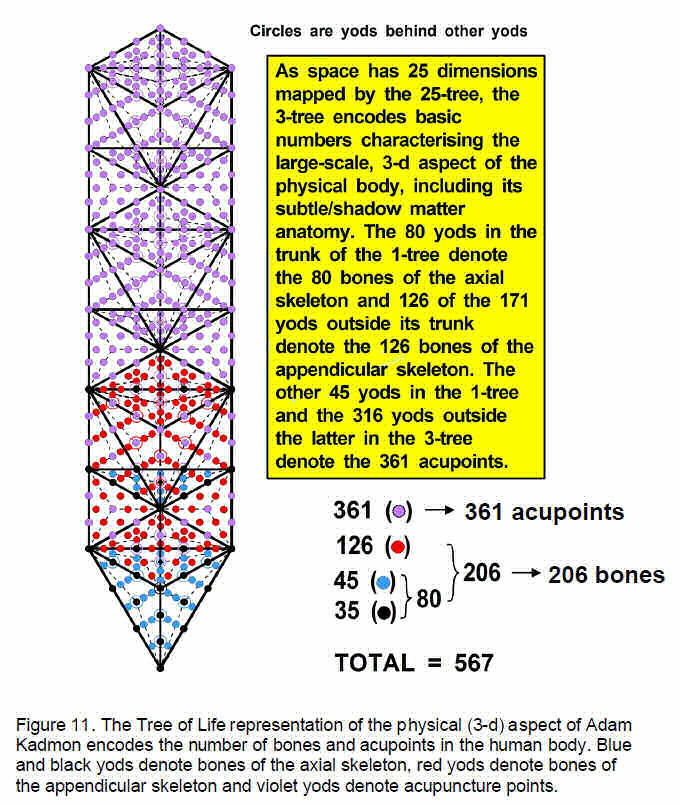ARTICLE 33
by
Stephen M. Phillips
Flat 4, Oakwood House, 117-119 West Hill Road. Bournemouth. Dorset BH2 5PH. England.
Website: http://smphillips.mysite.com
Abstract
|
The trunk of the Tree of Life is the geometrical sequence of point, line, triangle and tetrahedron. Their numbers of vertices are the integers 1, 2, 3 & 4 symbolized by the four rows of dots in the Pythagorean tetractys. With its triangles each divided into three tetractyses, the trunk has 80 yods symbolizing the 80 bones of the axial skeleton. Its branches have 126 yods symbolizing the 126 bones of the appendicular skeleton. The ancient Hebrew Godnames prescribe the composition of the trunk in terms of vertices, edges & triangles. It has 55 of these geometrical elements, where 55 is the sum of the first 10 integers. The axial skeleton has 34 types of single bones and 23 types of pairs of similar bones. The former is encoded in the inner Tree of Life as the 34 yods in its pair of triangles. The latter is encoded as the 23 pairs of yods in the pair of squares. With their sectors divided into three tetractyses, the pair of triangles and the pair of squares contain 206 yods. This is the number of bones in the human skeleton. The triangle with 19 yods also defines the 361 acupoints in the human body because 361 = 192. The yods of the trunk can be correlated in a 1:1 way with the bones of the axial skeleton. The 120 types of bones in the human skeleton are encoded in the inner Tree of Life as the 120 yods on the boundaries of the seven enfolded regular polygons. Their 34 corners outside their shared edge denote the 34 types of single bones in the axial skeleton. |
1
Introduction
Although the bodies of humans have evolved over millions of years, this development has not been a chain of changes that occurred by chance. According to religion, humans are spiritual beings as well as physical creatures. According to Judaic-Christian belief, they were designed “in the image of God.” According to Kabbalah, the Jewish, mystical tradition, this blueprint is the Tree of Life (Fig. 1). The divine prototype, Adam Kadmon, is represented by ten Sephiroth, or divine qualities.
At the top of the Tree of Life is Kether, the seed source of all being — both physical and superphysical. It emanates Chokmah, signifying the uncontrolled energy of the divine impulse, the fecundating life-force. Binah, the next Sephirah, imposes limit on this amorphous possibility, moulding it and making it more coherent and intelligible. This completes the Supernal Triad within the pure subjective nature of God. The next seven Sephiroth of Construction — Chesed, Geburah, Tiphareth, Netzach, Hod, Yesod & Malkuth — are divine qualities that are objective at all levels of reality. Malkuth, the last Sephirah, is the physical manifestation of Adam Kadmon, the divine prototype. At the level of everyday reality, it is the bones of a body. It was shown in Article 321 how the most Malkuth level of a human — his skeleton — conforms to the blueprint of the Tree of Life. This article will analyse further the correspondence between the two structures. By revealing their precise correlations and their beautiful mathematical attributes, it will prove that the physical bodies of humans are structured according to this diagram, thus confirming
2
their divine origin, poetically expressed in biblical Genesis.
1. The skeleton
The entire framework of the human body is known as the skeleton. It is made up of two primary groups of bones;1. axial skeleton. This group of bones are the ones that make up the head and actual trunk of the body. It has 80 bones;
2. appendicular skeleton. This is the group of bones that make up the body’s extremities (arms and legs). It has 126 bones.
This article will analyse the axial skeleton, which comprises the skull, hyoid, vertebral column and thoracic cage.
The entire group of bones that make up the head is called the skull and it too can be divided into two primary groups:
1. cranium. This is the rounded area that houses and protects the brain. It is comprised of eight distinct bones that are fused together in an adult;
2. facial area. The facial area is made up of fourteen separate bones, which include those that make up the jaws, cheeks and nasal area.
The eight bones that make up the cranium are:
1. frontal bone. The frontal bone is the one that comprises the forehead, the upper orbit of the eye and the forward parts of the cranium. The frontal bone also contains two air spaces that are called sinuses. The frontal bone is fused with the parietal bones at the top, the sphenoid bones, maxilla and nasal bones;
2. parietal bones. There are two parietal bones that form the largest portion of the top and sides of the cranium. They are fused down the middle at the top of the skull. In addition to the frontal bones, the parietal bones are also fused to the sphenoid, temporal and occipital bones;
3. temporal bones. Like the parietal bones, there are two distinct temporal bones. These bones are what form the lower, central sides of the skull. The temporal bones also hold the mastoid sinuses as well as parts of the ears;
4. ethmoid bone. There is only one ethmoid bone and it has a different consistency that the other bones in the head. Where they are hard and dense, the ethmoid bone is a delicate, spongy bone that is located between the eyes. It also forms a part of the frontal floor area of the cranium;
5. sphenoid bone. There are two sphenoid bones and they sit behind the eyes and run back towards the temporal bones;
6. occipital bone. There is only one occipital bone. It forms the back base of the skull.
The 14 facial bones include:
1. mandible. The mandible (lower jaw) is the only moveable bone in the skull;
2. maxillae. There are two maxillae bones. They are what comprise the upper jaw and each one of them contains a large “maxillary” sinus;
3. zygomatic. There are two zygomatic bones and they sit on either side of the skull and comprise the higher area of the cheek;
4. lacrimal bones. There are two small lacrimal bones that sit at the inside corner of each eye;
5. vomer. There is only one vomer bone and it is what forms the lower portion of the nasal septum;
6. nasal bones. The nasal bones are a pair of small, slender bones that support the actual bridge of the nose. They are fused at the top to the frontal bone and to the
3
maxillae at the area that completes the inside orbit of the eye.
In addition to the previous bones, there are six tiny bones (three pairs) called ossicles. They are located in the ears. They are joined in such a way as to amplify the sound waves received by the eardrum (tympanic membrane). The three bones are:
1. malleus. Often called the hammer are the two malleus bones (one in each ear).They are the first bones in the inner ear and appear similar in shape to a hammer. The “handle” part attaches to the tympanic membrane and the “head” portion attaches to the incus;
2. incus. The incus is also called the anvil and it is the middle of the three bones;
3. stapes. The stapes is the innermost bone and it appears very similar to a tiny stirrup. In fact, the stapes is often called the stirrup.
There is one final bone of the human skull. The tongue attaches to a single U-shaped bone called the hyoid bone. The hyoid is located underneath the skull, floating in the throat, and it forms the boundary between the head and neck. It is the only bone unconnected to any other bone.
There are 26 vertebrae in the Vertebral Column:
1. seven cervical vertebrae extend from the head to the thorax;
2. 12 thoracic vertebrae extend from the cervical portion to the lumbar section;
3. five lumbar vertebrae continue from the thoracic vertebrae to the sacrum;
4. the sacrum forms the posterior wall of the pelvis;
5. the coccyx is one mass of four to five (usually four) small coccygeal vertebrae that have fused into one commonly called the “tailbone.”The 25 bones in the Thoracic Cage consist of:
1. 14 true ribs. There are 7 pairs that reach the anterior body wall. They are connected to the sternum by separate cartilaginous extensions (costal cartilages);
2. 10 false ribs. Three pairs do not attach directly to the sternum. The last two pairs are floating ribs because they have no connection with the sternum;
3. sternum. Although one bone, it has three parts in the adult. The manubrium articulates with the clavicles of the appendicular skeleton and with the cartilages of the first pair of ribs. The body ends at the xiphoid process.
The bone composition of the human body can be written in the following, succinct way: a group of N bones will be written ‘N.’ If it is made up of n single bones and m pairs of bones (one on each side of the body), this can be written as:
N = n(1) + m(2),
where the number 1 in brackets denotes a single bone and the number 2 denotes bones present as pairs in the skeleton. Below are listed the compositions of the groups of bones making up the axial skeleton:
Skull (28)
cranium: 8 = 4(1) + 2(2);
face: 14 = 2(1) + 6(2);
ossicles: 6 = 3(2); 28 = 6(1) + 11(2).Hyoid (1)
1 = 1(1);
Vertebrae (26)
cervical: 7 = 7(1);
thoracic vertebrae: 12 = 12(1);
4
sacrum: 1 = 1(1);
coccyx: 1 = 1(1);Thoracic Cage (25)
ribs: 24 = 12(2).Adding up the single bones and the pairs of bones in the axial skeleton,
80 = 28 + 1 + 26 + 25
= 34(1) + 23(2).There are 34 single bones and 23 pairs of bones, i.e., 57 types of bones.
2. The trunk of the Tree of Life
It was pointed out in Article 322 that, when the 19 triangles of the lowest (“1-tree”) of any set of Trees of Life are each divided into their three sectors and the latter then turned into tetractyses, it comprises 251 yods (Fig. 2). Its trunk is the point (Kether), line (path joining Binah and Chokmah), triangle (Chesed–Geburah–Tiphareth) and tetrahedron (Netzach–Hod–Yesod–Malkuth).
This sequence of the first four simplexes symbolizing the integers 1, 2, 3 & 4 is the counterpart of the four rows of the tetractys with 1, 2, 3& 4 dots. The trunk contains 80 yods. The branches of the Tree (excluding the 45 yods originally outside the trunk) contain 126 yods. These are, respectively, the number of bones in the axial and appendicular skeletons. It was then shown in Article 32 that, when their triangles are similarly transformed, the three lowest, overlapping Trees of Life contain 567 yods. The 361 yods in these trees other than those denoting bones were identified with the 361 classical acupoints established in ancient China by many generations of acupuncturists. The significance of these three trees is that they map the
5
human body, which is 3-dimensional, and so both bones and acupoints should expect to be encoded in this particular number of overlapping trees. It was concluded that the trunk of the lowest Tree of Life represents the axial skeleton and that its branches with 126 yods represent the 126 bones of the appendicular skeleton, whilst the 361 yods in the remaining branches of the three lowest Trees of Life denote the 361 acupoints.
Let us now examine the yod populations of the trunk. The line representing the second stage of its generation has two endpoints, or vertices, and two hexagonal yods. Divided into three tetractyses, the triangle contains 19 yods made up of four vertices and 15 hexagonal yods, of which
12l ie on the six edges and three are at the centres of the tetractyses. The tetrahedron has four triangular faces that can be divided into 12 tetractyses. They have (4×3=12) edges inside each face and six edges that are edges of the tetrahedron. These 18 edges have (18×2=36) hexagonal yods. The tetrahedron has four vertices and there are four vertices of tetractyses within the faces, totalling eight vertices. Table 1 above displays the numbers of yods in the four parts of the trunk. It has 15 vertices, 36 hexagonal yods on edges/lines and 15 hexagonal yods at centres of tetractyses. There are 50 hexagonal yods on the 25 edges, a total of
6
Table 2. The number values of the 10 Sephiroth in the four Worlds.
SEPHIRAH
GODNAME
ARCHANGEL
ORDER OF ANGELS
MUNDANE CHAKRA
1 Kether
(Crown)
620
EHYEH
(I am)
21
Metatron
(Angel of the Presence)
314
Chaioth ha Qadesh
(Holy Living Creatures)
833
Rashith ha Gilgalim
First Swirlings
(Primum Mobile)
6362 Chokmah
(Wisdom)
73
YAHWEH, YAH
(The Lord)
26, 15Raziel
(Herald of the Deity)
248
Auphanim
(Wheels)
187
Masloth
(The Sphere of the Zodiac)
140
3 Binah
(Understanding)
67
ELOHIM
(God in multiplicity)
50
Tzaphkiel
(Contemplation of God)
311
Aralim
(Thrones)
282
Shabathai
Rest
(Saturn)
317Daath
(Knowledge)
4744 Chesed
(Mercy)
72
EL
(God)
31
Tzadkiel
(Benevolence of God)
62
Chasmalim
(Shining Ones)
428
Tzadekh
Righteousness
(Jupiter)
1945 Geburah
(Severity)
216
ELOHA
(The Almighty)
36
Samael
(Severity of God)
131
Seraphim
(Fiery Serpents)
630
Madim
Vehement Strength
(Mars)
956 Tiphareth
(Beauty)
1081
YAHWEH ELOHIM
(God the Creator)
76
Michael
(Like unto God)
101
Malachim
(Kings)
140
Shemesh
The Solar Light
(Sun)
6407 Netzach
(Victory)
148
YAHWEH SABAOTH
(Lord of Hosts)
129
Haniel
(Grace of God)
97
Tarshishim or Elohim
1260
Nogah
Glittering Splendour
(Venus)
648 Hod
(Glory)
15
ELOHIM SABAOTH
(God of Hosts)
153
Raphael
(Divine Physician)
311
Beni Elohim
(Sons of God)
112
Kokab
The Stellar Light
(Mercury)
489 Yesod
(Foundation)
80
SHADDAI EL CHAI
(Almighty Living God)
49, 363Gabriel
(Strong Man of God)
246
Cherubim
(The Strong)
272
Levanah
The Lunar Flame
(Moon)
8710 Malkuth
(Kingdom)
496
ADONAI MELEKH
(The Lord and King)
65, 155Sandalphon
(Manifest Messiah)
280
Ashim
(Souls of Fire)
351
Cholem Yesodoth
The Breaker of the Foundations
The Elements.
(Earth)
168
7
(50+15=65) hexagonal yods, whilst (50+15=65) yods form the boundaries of the 15 tetractyses. As Table 2 shows, 15 is the number value of YAH, the Godname assigned to Chokmah, 50 is the number value of ELOHIM, Godname of Binah, the member of the Supernal Triad opposite Chokmah, 36 is the number value of ELOHA, Godname of Geburah, which is the Sephirah below Binah on the Tree of Life, and 65 is the number value of ADONAI, the Godname of Malkuth. It is a remarkable illustration of how Godnames prescribe the properties of sacred geometry. ADONAI prescribes the form of the trunk because this is delineated by 65 yods. In keeping with the meaning of Chokmah, its Godname defines the 15 points in space defining this form in potentia, whilst the Godname of Binah makes this form explicit by prescribing the extra 50 hexagonal yods needed to do this.
The Godname of Geburah gives form to the last member of the sequence of four mathematical objects by prescribing the number of hexagonal yods on lines. The fact that it does so is a sign that the tetrahedron is a holistic object per se with archetypal properties, being the first member of the set of five regular polyhedra. Another indication is the fact that it has 48 hexagonal yods, of which 12 are at centres of tetractyses and 36 are on their edges. This 36:12 division has its counterpart in the inner form of the Tree of Life (Fig. 3) as the 36 corners of the first six polygons and the 12 corners of the seventh polygon. The counterpart of these 48 hexagonal yods in the outer form of the Tree of Life is its 48 corners, edges and triangles.Table 3 tabulates the geometrical composition of the trunk of the Tree of Life before its triangles are divided into three tetractyses:
YAHWEH with number value 26 prescribes the trunk because the latter has 26 vertices, edges, triangles & tetrahedra. YAH, its older version, prescribes the tetrahedron because it has 15 geometrical elements. The values of the letters Y, H & V of YAHWEH (YHVH) denote various combinations of geometrical elements. Y (yod) with number value 10 is the number of vertices, H (heh) with number value 5 is the number of triangles & tetrahedra in the tetrahedron or the number of edges & triangles in the line and triangle, and the value 6 of V (vau) is the number of edges of the tetrahedron.
Table 4 tabulates the geometrical composition of the trunk when its triangles are divided into three tetractyses:

8
It now has 15 vertices, 40 vertices & edges and 55 vertices, edges & triangles, where 55 is the tenth triangular number:
2 3
4 5 6
7 8 9 10 .This beautiful property harmonises with the fact that the trunk symbolises the number 10 as the sum of the integers 1, 2, 3 & 4 symbolised by the rows of the tetractys. As
55 = 12 + 22 + 32 + 42 + 52,
and as the trunk originally had 25 (= 52) vertices, edges & triangles, 30 geometrical elements are added to the trunk, where
30 = 12 + 22 + 32 + 42.
This further demonstrates the mathematical beauty of the trunk of the Tree of Life — its geometry harmonises with the squares of integers. What could demonstrate more perfection than the fact that 55 geometrical elements are needed to define the trunk with 80 yods — the Tree of Life representation of the axial skeleton of the human body! Mathematical as well as aesthetic beauty is inherent in its design.
Further examples of these properties are listed below:
1. number of Sephirothic vertices = 10 = 1 + 2 + 3 + 4;
2. number of vertices and yods at centres of tetractyses = 15 + 15 = 30 = 12 + 22 + 32 + 42;
3. number of hexagonal yods at centres of 15 tetractyses = 15 = 1 + 2 + 3 + 4 + 5;
4. number of yods other than Sephirothic points lying on edges = 65 – 10 = 55 = 12 + 22 + 32 + 42 + 52;
5. number of yods on edges of tetractyses = 15 + 50 = 65 = 15 + 24 + 33 + 42 + 51;
6. number of boundary yods in tetrahedron = 8 + 36 = 44.Table 3 shows that the trunk has 15 vertices and 41 edges, triangles & tetrahedra. The number 41 is the 21st odd integer, where 21 is the number value of EHYEH. The number 41 is also the sum of the number values 15 and 26 of, respectively YAH and YAHWEH. The tetrahedron has eight vertices and 18 edges, i.e., 26 vertices and edges, demonstrating how it is prescribed by YAHWEH. The total number of geometrical elements is 56. They contain 80 yods, where 80 is the sum of the number values 21 and 49 of, respectively, EHYEH and EL CHAI, Godname of Yesod, the number value of which is 80. The translation “foundation” for Yesod is apt, given that its number value is the number of bones in the axial skeleton — the basis of the human body.
3. The axial skeleton as the trunk of the human Tree of Life
It was found at the end of Section 1 that the axial skeleton consists of 34 single bones and 23 pairs of bones. 34 is the 33rd integer after 1, where 33 = 1! + 2! +3! +4!, and 23 is the 22nd integer after 1, where 22 = 14 + 23 + 32 + 41, demonstrating how the Pythagorean integers determine the two basic numbers characterizing the human axial skeleton. It consists of 57 types of bones, where 57 = 26 + 31 = 21 + 36, showing how the number values of the Godnames YAHWEH, EL, EHYEH and ELOHA determine how many types of bones make up the axial skeleton. There are 57 triangles in the lowest of the three overlapping Trees of Life mapping the 206 bones and 361 acupoints.3 15 of these with 80 yods symbolizing the 80 bones of the axial skeleton9
belong to its trunk and 42 of them with 126 yods symbolizing the 126 bones of the appendicular skeleton define its branches. 42 is the 21st even integer, showing how EHYEH prescribes this skeleton. Indeed, 126 is the sum of the number values of the four types of combinations of the letters A, H and I in EHYEH (AHIH):
1 A + H + I = 16 2 AH + HI + AI + HH = 42 3 AHI + HIH + AHH = 47 4 AHIH = 21 = 126 Furthermore, this number has the remarkable property that it is the arithmetic mean of the first 26 triangular numbers, 26 being the number value of the Godname YAHWEH:
This once again illustrates the archetypal nature of the Divine Names in mathematically determining both the bone composition of the human skeleton and the geometrical properties of its Tree of Life mapping.
The human cell has 23 pairs of chromosomes, which makes it remarkable that the axial skeleton should have the same number of pairs of bones! This, however, is not a coincidence. Both the body and its cells are holistic systems structured according to the cosmic blueprint of the Tree of Life. They must therefore display the same set of parameters characterising such systems. As the number of chromosomes in the nucleus of the cell or as the number of bones existing as pairs in the axial skeleton, the number 46 is one such parameter. 46 = 15 + 31, showing how it is determined by the number values of YAH and EL, the Godnames of Chokmah and Chesed located on the Pillar of Mercy of the Tree of Life.
The other bone parameter, 34, is encoded in the inner form of the Tree of Life (Fig 4.). This consists of two sets of seven enfolded, regular polygons, one the mirror image of the other. They are the triangle, square, pentagon, hexagon, octagon, decagon and dodecagon. Mathematically prescribed by the ten Godnames, these 14 polygons
10
encode the gauge symmetry group E8×E8 of the heterotic superstring and its structural parameter 168, as discussed in many earlier articles. The key to this encoding of scientific information in the inner Tree of Life is the transformation of the sectors of each polygon into tetractyses. Figure 5 shows that, when thus transformed, the pair of triangles joined at the ‘root edge’ contains 34 yods. Each symbolizes a single bone of the axial skeleton. Making use of the information about bones discussed in Section 1 and dropping brackets for each group of bones, the compositions of the 34 bones are:
34 = 1 + 1 + 1 + 1 + 4 + 2 + 7 + 12 + 5,
where the first four 1s denote the hyoid, sternum, sacrum and coccyx, 4 denotes the four single bones of the cranium, 2 is the two single facial bones, 7 is the seven cervical vertebrae, 12 is the 12 thoracic vertebrae and 5 is the five lumbar vertebrae. Can the bones be assigned unambiguously to the yods in the two triangles? Any such assignment must respect the intuitively reasonable rule that bones of the same group, e.g., the cranium, should be denoted in a way that does not distinguish between the two triangles. They should also carry out, geometrically
speaking, the same function that their corresponding bones do in the skeleton. For example, the coccyx is the lowest bone in the axial skeleton, so its yod should be the base of the pair of triangles. These rules restrict possible assignments but not enough to make only one possible. What is
11
important here, however, is not what the ‘correct’ assignment is but the very fact that it is possible to assign single bones in an uncontrived way to the yods of the pair of triangles, as Fig. 5 demonstrates.
That this could be coincidental is made highly unlikely by the amazing fact that the next polygon — the square — embodies the number of pairs of bones in the axial skeleton! (Fig. 6). Each square has 25 yods, that is, 21 yods outside their shared edge, so that the pair of them has (21+25=46) yods. In this case, there is no ambiguity of assignment of bones to yods. The 12 ribs on one side of the body are symbolized by the 12 yods inside the square that surround its centre. The six bones on either side of the face are denoted by the six hexagonal yods on the sides of each square. The two pairs of cranial bones are denoted by the two pairs of yods on the shared side of the squares, whilst the pair of three ossicles corresponds to the centre and two corners of each square.
Just as the 206 yods corresponding to the bones of the human body were created by dividing the triangles of the lowest Tree of Life into three tetractyses, we find that similar transformation of the pair of triangles and the pair of squares yields the same number of yods (Fig. 7)! The triangle has 46 yods, of which 42 yods lie outside its edge shared with the other triangle. The pair of joined triangles contains (42+46=88) yods. The square has 61 yods, of which 57 yods lie outside its shared edge. The pair of joined squares contains (57+61=118) yods. There are (88+118=206) yods in the pair of triangles and the pair of squares. Whereas the transformation of the sectors of the pair of triangles and the pair of squares into single tetractyses generates 80 yods symbolizing the 80 bones of the axial skeleton, their transformation into three
tetractyses generates 206 yods symbolizing the 206 bones of both skeletons. The additional number of yods is the number of bones in the appendicular skeleton! This remarkable result demonstrates beyond doubt the Tree of Life nature of the human skeleton.
It was found earlier that ADONAI, the Godname of Malkuth with number value 65, prescribes the trunk of the Tree of Life because 65 yods lie on the edges of its lines (alternatively, it has 65 hexagonal yods). As the triangle contains 19 yods when its sectors are turned into tetractyses and 46 yods when they are divided into three tetractyses (Fig. 8), the pair of such triangles has 65 yods. In the context of the 1-tree, the most ‘Malkuth’ level of all, the 19 yods symbolise its 19 triangles with 80 yods.
The number 19 also determines the number of classical acupoints in the human body because 361 = 192. The tenth odd integer is 19, showing how this fundamental parameter is defined by the Decad, called “all complete” or “fully accomplished” by the Pythagoreans, entranced by its virtues. It also defines the form of the trunk of the Tree of Life delineated by 65 yods because 65 is the sum of the first ten integers after 1:
12
13
3 4
5 6 7
8 9 10 11 .Figure 9 identifies the 80 yods of the trunk of the Tree of Life in terms of the 80 bones of the human axial skeleton.
4. The appendicular skeleton
Listed below is the composition of bones in the appendicular skeleton (see Fig. 1):Pectoral girdle (4)
1. scapula (2) is commonly called the “shoulder blade” and is supported and positioned by the skeletal muscles. It has no bony or ligamentous bonds to the thoracic cage, but is extremely important for muscle attachment;
2. clavicle (2) is commonly called the "collarbone" and articulates with the manubrium of the sternum, and is the only direct connection between the pectoral girdle and the axial skeleton.Upper Limbs (60)
1. humerus (2) extends from the scapula to the elbow;
2. radius (2) lies along the lateral side (or thumb side) of the forearm;
3. ulna (2) forms the medial support of the forearm;
4. carpals (16) are 8 pairs of bones of the wrist and are composed of four proximal bones (scaphoid, lunate, triangular or triquetral, and the pisiform bone) and four distal bones (trapezium, trapezoid, capitate, and the hamate bone);
5. metacarpals (10) are 5 pairs of bones that articulate with the distal carpal bones forming the palm of the hand;
6. phalanges (28) are 14 pairs of “finger” bones. Four fingers contain three phalanges while the pollex (thumb) has only two.Pelvic girdle (2)
os coxae (2) is commonly called the “hip bone.” It is formed from a fusion of three bones (ilium, ischium, and pubis).Lower Limbs (60)
1. femur (2), commonly called the “thigh bone,” is the longest, strongest, and heaviest bone in the body. Distally, it articulates with the tibia at the knee joint. The head (epiphysis) articulates with the pelvis at the acetabulum;
2. tibia (2), commonly called the “shinbone,” is the large medial bone of the leg, attached to the patella by a ligament;
3. fibula (2) parallels the lateral border of the tibia;
4. patella (2) is the “knee cap;”
5. tarsals (14) include 7 pairs of bones (talus, calcaneus, navicular, cuboid, and the 1st, 2nd, and 3rd cuneiform bones). Only the talus articulates with the tibia and fibula;
6. metatarsals (10) support the sole of the foot and numbered 1 to 5 from medial to lateral with the distal ends forming the ball of the foot;
7. phalanges (28) have the same arrangement as with the fingers and thumb only with the toes and great toe (hallux).The appendicular skeleton has 126 bones grouped in 63 pairs. Together with the 23 pairs of bones in the axial skeleton, there are 86 pairs in the two skeletons. 86 = 50 + 36, where 50 is the number value of ELOHIM, the Godname of Binah, and 36 is the
14
number value of ELOHA, the Godname of Geburah, the Sephirah below Binah on the Pillar of Judgement. This illustrates the formative character of these two Sephiroth, for their Godnames determine how many pairs of bones are in the human body. We found at the end of Section 1 that the axial skeleton has 57 types of bones. Both skeletons therefore have (63+57=120) types of bones, where
15
120 = 22 + 42 + 62 + 82.
This demonstrates how the Tetrad Principle4 determines the number of types of bones in the human skeleton. As 112 = 121 = 1 + 3 + 5 +… + 21, 120 is the sum of the first ten odd integers after 1:
5 7
9 11 13
15 17 19 21 .Designed according to the blueprint of the 10-fold Tree of Life, the human body exhibits in its types of bones the perfection of the Decad, called “God,” “Cosmos,” and “All Perfect” by the ancient Pythagoreans. This beautiful property is prescribed by the Divine Name EHYEH with number value 21 because the number 120 is the sum of all the odd integers up to 21, the Pythagoreans not counting the number 1 even as an integer, let alone as an odd one, because they regarded it as the Divine Monad, the source of all number.
The number 120 is truly a measure of the perfection of the human skeleton for the following reason: when the 47 sectors of the seven enfolded polygons constituting the inner form of the Tree of Life are turned into tetractyses, there are 120 yods on their 42 sides (Fig. 10). Each yod symbolizes a degree of freedom expressing the nature of the holistic system designed according to the Tree of Life. Although (just as the body has more than 120 bones) the 120 yods do not quantify completely the seven polygons, which have 264 yods, they do define their extent. As the number of types of bones, the number 120 likewise quantifies how many different degrees of freedom express the form of the corporal Tree of Life. The 34 corners of the seven polygons outside their shared edge denote the 34 types of single bones in the axial skeleton. The 23 yods on the sides of the dodecagon denote the 23 types of paired bones in the axial skeleton and the 63 remaining yods on the sides of the first six polygons denote the 63 types of bones of the appendicular skeleton.
The lowest Tree of Life contains 251 yods. Its trunk has 80 yods and 171 yods form its branches. Of these, 126 yods denote the bones of the appendicular skeleton, the remaining 45 yods and the 316 yods in the next two trees denoting the 361 classical acupuncture points in the human body. Figure 11 displays the 567 yods symbolizing both the 206 bones and the 361 acupuncture points. Identification of individual yods in terms of bones of the appendicular skeleton will not be attempted in this article.
References
1 Phillips, Stephen M. Article 32: “Derivation of the bone & classical acupoint compositions of the human body and their relationship to the seven musical scales,” (WEB, PDF).
4 Phillips, Stephen M. Article 1: “The Pythagorean nature of superstring and bosonic string theories,” (WEB, PDF), p. 4.
16

